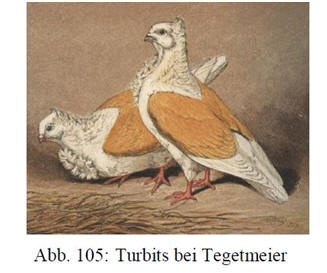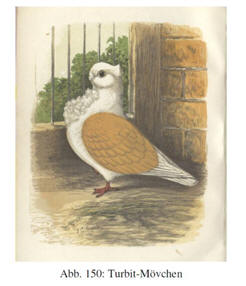|
Turbitology by D. L. White
--
Turbitology von D. L. White (deutsch)
Turbitology
is a sophisticated book of
128 pages by Donovon L. White about the Turbit-Pigeon. It's more
than the subtitle 'A Study of the Modern-Type Turbit Pigeon'
reveals. The author enters the history of today's turbits
knowledgeably using historical literature and the available
pictorial material. Keeping and rearing, preparations for the show,
a detailed discussion of the standard and an introduction to the
heredity relevant for the colors and pattern follow.
 
The writing has a general
significance for the understanding of development processes of
breeds in the pigeon fancier in addition to the interest it will
find at Turbit breeders worldwide. Individual breeders develop
visions, they communicate them through striking drawings, in which
the essential breed characteristics in part voluntary be
exaggerated. What has been the 'Simpson Magpie' for the English
Long-Beaked Magpies 1909, that was for the Turbits the 'Ideal Turbit'
by E. B. Ulrich in 1916, a deviating from the official standard
'with much more frontal reach'. If other breeders and judges also
jump on such visions without regard to the official standards, then
with courage to experiment and cross-breed, a whole breed can be
quickly transformed. Turbits are an example of this.
Turbits were already
considered by Willughby 1679 and Moore 1735 next to the Owls as a
separate breed. Tegetmeier 1868 shows them with a slightly angular
head clearly different than Owls with round heads.


Turbits bei
Tegetmeier 1868 und Lyell 1887 aus dem Buch "Taubenrassen.
Entstehung, Herkunft, Verwandtschaften", Achim
2009.
At Lyell 1887 one can
still read that the question of the ideal Turbit head was
controversial. Lyell himself belonged to the section of those who
saw in the head of the English Owl and the 'African Owl' also the
ideal Turbit head. That is demonstrated in his drawing but did not
stop the development of the frontal length of the Turbits.
Particularly impressive in the writing of White are the
representations of different head shapes, different approaches of
the beak setting, demonstrating the importance of the relative seat
of the eye and the frontal length. For other breeds the face is of
similar importance. Breeders of other breeds could learn how
significant beak setting and face length are for a breed. With
reference to his mentor J. G. Muir, Donovon White points out the
differences
between the Turbit head and African Owls and Orientals. He refers on
Muir's graphs from 1949 that were also reproduced in a 'Special' of
the American Pigeon Journal on Turbits in July 1976. Impressive at
pages 60 ff. the discussion of standard details with illustrations
of
the relative positioning of beak, eye, peak crest and back of the
head. He hesitates not also to give concrete numbers that allow also
newcomers a quick orientation.

Werner Assmuss
and Werner Hegemann (eds.), Mövchentauben international, Reutlingen
1979
In a time when hardly any breeder knows the difference between face
and beak length in other breeds, this elaborated work could even
lead to new insights at other breeds. For the understanding of a
breed, not only monographs about that breed are important. It is
also important to know their position in the structure of the
related races. This is especially true if you think about the
development of breeds. This is how the special features of the
Turbit heads by White are worked out in comparison to Oriental
Frills and African Owls. For those who want to look beyond this
horizon, the anthology edited by Assmuss / Hegemann about owl breeds
worldwide is indispensable, German-language, but with English
summaries Experienced owl breeders will also be able to get from
White's book many practical tips for breeding, keeping and
exhibition preparation. The depiction of the emergence of the modern
type of Turbits gives rise to a feeling for the special nature of
the breed. The explanations on the details of the standard
provisions and the differences to the related breeds are equally
important for exhibitors, judges and the further breeding
orientation, so that the writing deserves a great readership.
Literature:
American Pigeon Journal,
July 1976, Issue Devoted Especially to Turbits.
Assmus, Werner, und Werner Hegemann (eds.),
Mövchentauben international, Owls, Frills, Turbits, Reutlingen 1979,
German with English summaries.
Kleinpell, George J., The
Turbit Handbook, Cleveland, Ohio 1968
Sell, Axel, Taubenrassen. Entstehung, Herkunft,
Verwandtschaften. Faszination Tauben über die Jahrhundert, Achim
2009.
White, Donovon L., Turbitology.
A Study of the Modern-Type Turbit Pigeon,
Published October 2017 by Classic Pigeon Books - Hemet, California,
USA
|